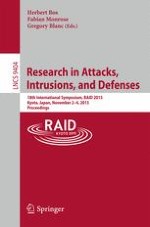2015 | OriginalPaper | Buchkapitel
Elite: Automatic Orchestration of Elastic Detection Services to Secure Cloud Hosting
verfasst von : Yangyi Chen, Vincent Bindschaedler, XiaoFeng Wang, Stefan Berger, Dimitrios Pendarakis
Erschienen in: Research in Attacks, Intrusions, and Defenses
Aktivieren Sie unsere intelligente Suche, um passende Fachinhalte oder Patente zu finden.
Wählen Sie Textabschnitte aus um mit Künstlicher Intelligenz passenden Patente zu finden. powered by
Markieren Sie Textabschnitte, um KI-gestützt weitere passende Inhalte zu finden. powered by
